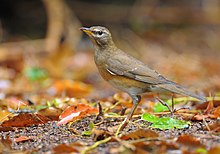Eyebrowed thrush
| Eyebrowed thrush Temporal range: Late Pleistocene – present
| |
|---|---|

| |
| Scientific classification | |
| Domain: | Eukaryota |
| Kingdom: | Animalia |
| Phylum: | Chordata |
| Class: | Aves |
| Order: | Passeriformes |
| Family: | Turdidae |
| Genus: | Turdus |
| Species: | T. obscurus
|
| Binomial name | |
| Turdus obscurus Gmelin, 1789
| |
The eyebrowed thrush (Turdus obscurus) is a member of the thrush family Turdidae. The scientific name comes from Latin Turdus, "thrush" and obscurus "dark".[2]

It breeds in dense coniferous forest and taiga eastwards from Siberia and Mongolia to Japan. It is strongly migratory, wintering south to China and Southeast Asia. It is a rare vagrant to western Europe.
It nests in trees, laying 4-6 eggs in a neat nest. Migrating birds and wintering birds often form small flocks. It is omnivorous, eating a wide range of insects, earthworms and berries.

This is an attractive thrush, with a grey back and head, the latter having a black eyeline, bordered white above and below. The breast and flanks are orange, and the belly white. The sexes are fairly similar, but immatures have a browner back.
The male has a simple whistling song, similar to the related mistle thrush.
In 2007 an eyebrowed thrush was sighted at the Jerusalem Bird Observatory in Jerusalem.[3] This is the second recorded sighting in Israel; the first was at Eilat in October 1996.
In 2011, an eyebrowed thrush was sighted in Australia, near Malanda in Queensland.[4] This is possibly the first confirmed sighting of the species on the Australian mainland.
Fossil record
In 2017, an assessment of late Pleistocene Indonesian passerines found a fossil of this species.[5]
References
- ^ BirdLife International (2012). "Turdus obscurus". IUCN Red List of Threatened Species. 2012. Retrieved 26 November 2013.
{{cite journal}}: Invalid|ref=harv(help) - ^ Jobling, James A (2010). The Helm Dictionary of Scientific Bird Names. London: Christopher Helm. pp. 278, 393. ISBN 978-1-4081-2501-4.
- ^ Jacobs, Megan (5 November 2007). "Rare bird is sighted in Jerusalem". Jerusalem Post. Retrieved 4 October 2017.
- ^ "Eye-browed Thrush – First for Australia, Feb. 9, 2011, Bird-o.com". Archived from the original on 2012-07-08. Retrieved 2011-12-08.
- ^ Meijer, Hanneke J.M.; Awe Due, Rokus; Sutikna, Thomas; Saptomo, Wahyu; Jatmiko; Wasisto, Sri; Tocheri, Matthew W.; Mayr, Gerald (2017-08-17). "Late Pleistocene songbirds of Liang Bua (Flores, Indonesia); the first fossil passerine fauna described from Wallacea". PeerJ. 5. doi:10.7717/peerj.3676. PMC 5563437. PMID 28828271.
{{cite journal}}: CS1 maint: unflagged free DOI (link)

